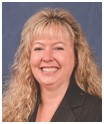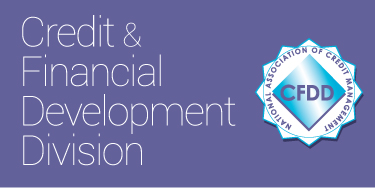
Meet Your 2019 National Chair
Sheryl Rasmusson, CCE
Life’s challenges are what make day-to-day endeavors worthwhile and meaningful, which is what drew Business and Credit Manager Sheryl Rasmusson, CCE, to the chair seat on the National Association of Credit Management’s Board of Directors. Her journey into business credit began in the early 2000s when she started working for Kilgore Architectural Products, Inc. in Spokane, Washington, where she remains today.
The woman who was working [at Kilgore] before me explained what NACM was,” Rasmusson recalled. “When I first went to a subcontractors and suppliers industry group, I had no idea what they were talking about. I was like, ‘This doesn’t make any sense to me at all.’ Then, I had a couple of mentors within the group who taught me how it worked and what things meant. It was my first introduction into credit.”
Rasmusson’s eyes weren’t always set on business credit though. Her original plan was to become a teacher, as she studied elementary education at Lewis-Clark State College in Lewiston, Idaho. After some educational course correcting, Rasmusson said her interest veered into construction, and she began her career in the administration department at ALSC Architects in 1993. She later shifted to general contracting work in 1998, where she handled another company’s contracts and marketing as well as accounts payable and accounts receivable until 2003.
Coinciding with Credit
 Ten years into the workforce, Rasmusson found herself the business and credit manager at Kilgore, where she harnessed her knowledge of the construction industry to advance her career as a credit professional. It wasn’t until Rasmusson began working to obtain her Credit Business Associate (CBA) designation—which she earned in 2011—that credit and her career coincided.
Ten years into the workforce, Rasmusson found herself the business and credit manager at Kilgore, where she harnessed her knowledge of the construction industry to advance her career as a credit professional. It wasn’t until Rasmusson began working to obtain her Credit Business Associate (CBA) designation—which she earned in 2011—that credit and her career coincided.
“We do a lot; credit is just one little piece of the puzzle,” Rasmusson said. “I handle contractors’ insurance, purchase orders and anything and everything in between. Credit is just one component of that, but I know I wouldn’t be where I am today without that piece.”
Using credit, Rasmusson verifies customers’ creditworthiness, albeit differently than the average supplier because Kilgore bases a lot of business on prevailing wage, she said. Since so many of their contracts are state-funded, credit risk only heightens when the company works with customers in the private sector. NACM’s Business Credit Principles and accounting courses fueled Rasmusson’s passion for credit in her pursuit of the Credit Business Fellow (CBF) and, later, Certified Credit Executive (CCE) designations.
During this time, Rasmusson said she also participated in NACM’s Spokane subcontractors and suppliers industry group. The face-to-face monthly meetings give credit managers in the area the opportunity to collect, compile and exchange credit experience information in addition to discussing improvements in credit management techniques and other subjects of general interest to members of the industry.
“In 2010, I was asked to serve as the industry chair and did that for about two years,” said Rasmusson, who was also serving a three-year term as director on the local board of directors. In 2013, Rasmusson’s service extended to the local board’s second chair and today, she is the first chair. “Back then, we had between 23 and 28 people attending meetings each month. It has dropped significantly since then, but we had a very active subs and suppliers group until the recession hit.”
Yet, Rasmusson said she continued to introduce challenges to the group at every meeting, such as developing a fun game for attendees to find potential members for NACM, entering participants’ names into prize drawings. Innovative thinking and lighthearted attitudes are necessary for the growth of industry groups and NACM in general, she said. Rasmusson further explained how leaders must learn when and how to ask the right questions.
That’s not to say Rasmusson hasn’t had to overcome any hurdles during the course of her 15-year career with Kilgore. For example, in 2008, Rasmusson’s newfound knowledge of business credit was put to the test when she encountered her first and only write-off of $1,400. While completing the requirements for her CCE, Rasmusson learned investigative tools to ensure a private customer’s creditworthiness before following through with setting the foundation for a business relationship.
“I was devastated and wondered if there was something I could’ve done to prevent that from happening,” Rasmusson said. “That really got me into protection mode, where I’m evaluating risk and managing it in a way so we’re constantly making sure our payments are coming in a timely manner.”
Growing NACM
Rasmusson is still determined to better herself in the field of credit through career challenges. While serving on her local board, Rasmusson also worked on the scholarship, executive, nominating and events committees, and has attended more than 50 classes at NACM’s yearly Credit Congress & Expo, Western Regional Conference and NACM Inland Northwest. Her work was honored in 2014 when she received the local CBA Designee of the Year Award as well as the NACM National CBA Designation of Excellence Award.
With Rasmusson’s next venture as chairwoman of NACM National’s Board of Directors, the credit manager said she’s spending time reflecting on her history with NACM and appreciating the integrity of the organization and what it stands for. Outgoing/Immediate past Chair Kenny Wine, CCE, the director of credit for the Southeast Region at Joseph T. Ryerson Inc. in Little Rock, Arkansas, said Rasmusson will make a great chair.
“Sheryl is a great listener. She allows people to voice their opinion uninterrupted, she is very thoughtful in her review of a situation, and she is able to form a position that is based on sound judgment,” Wine said. “My one piece of advice for her is … to be bold in your decision-making, think outside of the box, be innovative, and don’t shy away from new ideas.”
Rasmusson said her personal and professional growth became what it is today in large part because of NACM. Although she never imagined becoming the chair of NACM National, she said running for the seat gave her the chance to attend meetings and industry groups throughout the area to find out what is the next step for herself, the organization and its members.
Rasmusson recognizes that more challenges are ahead, but she isn’t worried. Instead, she is focused on the growth and wellbeing of NACM and its members, with the goal of strengthening the bond between all board members and providing encouragement to those who need it the most.
“I challenged each of my board members when I was on the local board. I said, ‘If you all can bring in one member, think about where we would be,’” Rasmusson said. “We all get so wrapped up in what we’re doing, but imagine if each board member brought in one company, how we could grow and build. I believe that 2019 will be a turning point for unity. I hope to incorporate the beliefs of the founding companies into everything we do, while encompassing new people into the circle of NACM.”
 By January 10
By January 10![]() Begin planning which programs and members to nominate for CFDD National Awards, due on March 15th
Begin planning which programs and members to nominate for CFDD National Awards, due on March 15th By February 1
By February 1![]()
![]()
 By March 15
By March 15![]()
 By April 1
By April 1 By April 1
By April 1 By April 10
By April 10 By April 15
By April 15 Leadership Report
Leadership Report By June 1
By June 1
 By July 10
By July 10![]()
 By August 1
By August 1 By October 1
By October 1 By December 1
By December 1 By December 31
By December 31































 As early as 1923, the idea of organizing a Credit Women’s group as part of NACM was proposed and almost immediately accepted by then active credit women executives. The cities of Los Angeles, Philadelphia, New York and St. Louis led the way.
As early as 1923, the idea of organizing a Credit Women’s group as part of NACM was proposed and almost immediately accepted by then active credit women executives. The cities of Los Angeles, Philadelphia, New York and St. Louis led the way.
 Ten years into the workforce, Rasmusson found herself the business and credit manager at Kilgore, where she harnessed her knowledge of the construction industry to advance her career as a credit professional. It wasn’t until Rasmusson began working to obtain her Credit Business Associate (CBA) designation—which she earned in 2011—that credit and her career coincided.
Ten years into the workforce, Rasmusson found herself the business and credit manager at Kilgore, where she harnessed her knowledge of the construction industry to advance her career as a credit professional. It wasn’t until Rasmusson began working to obtain her Credit Business Associate (CBA) designation—which she earned in 2011—that credit and her career coincided.